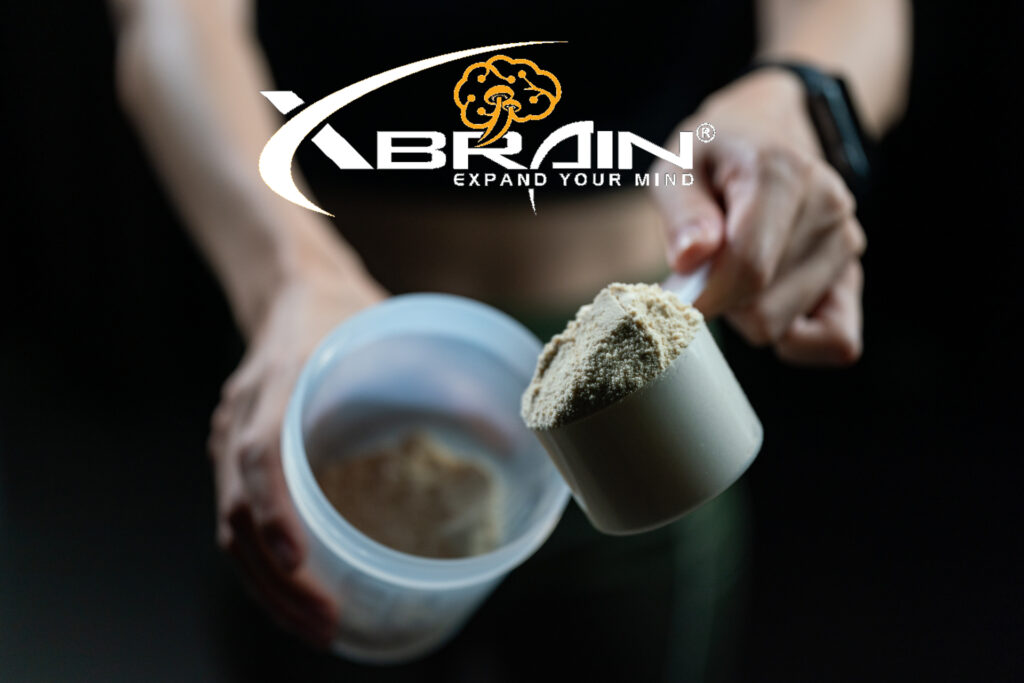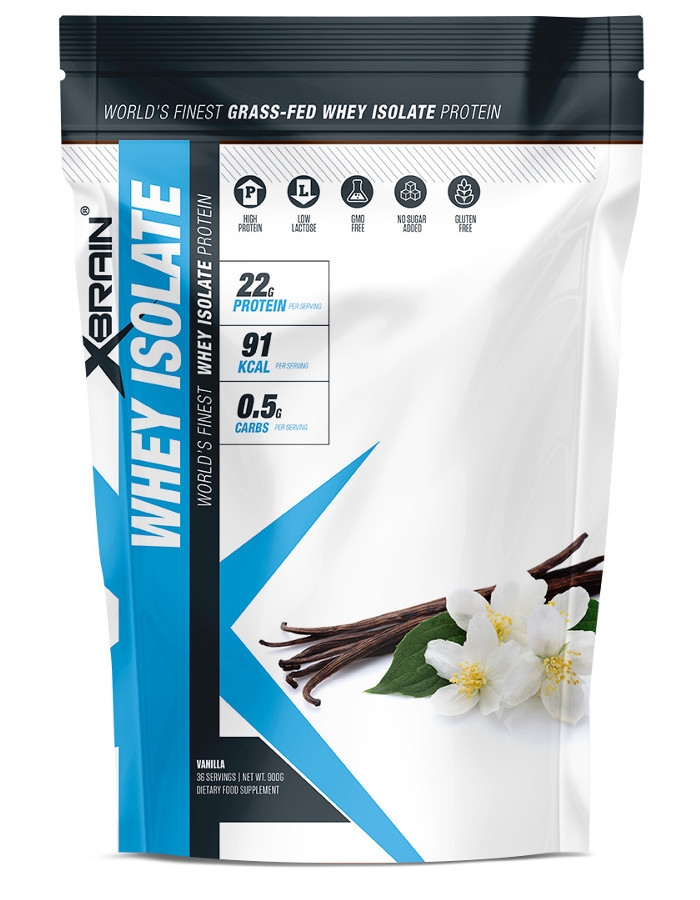
Looking for a high-quality whey protein that can help elevate your fitness routine and overall health? Look no further than XBrain Gras fed Whey Protein! Made from the milk of grass-fed cows, this premium whey protein is renowned for its rapid absorption and digestibility, delivering essential nutrition and benefits that can help maximize your workouts, increase your energy levels, boost your immune function, promote healthy digestion, and support your heart health. Keep reading to learn more about the unique protein structure and isolation methods that make Xbrain Whey Protein so effective, and discover how to choose the best whey protein for your fitness and health goals.
The Protein Powerhouse of Cow’s Milk
XBrain Grass-fed Whey and it`s Unique Nutrition and Benefits from Essential Amino Acids and Antioxidants
Cow’s milk contains two main groups of proteins known as whey protein and casein protein. The whey protein is a mixture of beta-lactoglobulin (65%), alpha-lactalbumin (25%), bovine serum albumin (8%) and immunoglobulins. Scientific research indicates that the benefits of whey protein actually come from beta-lactoglobulin and alpha-lactablbumin as they regulate more than 200 genes.
Whey-protein comes in three forms which includes concentrate (WPC), isolate (WPI) and hydrolysate (WPH). Whey-protein concentrates have relatively low levels of fat and cholesterol but have higher levels of carbohydrates in the form of lactose and higher bioactive ingredients. Whey-protein isolates are treated to remove fat and lactose but because so are lower in bioactive compounds. Whey-protein hydrolysates are predigested proteins making a mix of amino acids where the protein has been broken down with acid, alkali or enzymes.

Understanding XBrain Gras fed Whey Protein’s Nutrition and Benefits through its Unique Protein Structure and Isolation Methods
Whey protein concentrates have a high biological value that supply high amounts of the essential amino acids you need if they come from grass-fed organic cows. Unlike some whey protein concentrates and isolates, our grass-fed organic whey protein concentrate is not exposed to extreme temperatures or changes in pH (acid) that alters protein structure. This makes XBrain Whey Protein a superior product.
The structure of a protein meaning its folding conformation determines its function. Once the structure is altered, the protein becomes inactive. Proteins are very sensitive to changes in pH and heat and denature (change shape) easily.
Grass-fed organic whey processed properly so that it is undenatured has the ability to deliver the best nutrition. XBrain Whey Protein is a by-product of raw milk cheese production from antibody-free, hormone-free cows. It is heated at 70 degrees C for 15 seconds, then cooled to 5 degrees C for the remaining process. It just doesn’t get any better than grass-fed organic whey properly processed to maintain proper protein structure.
XBrain Whey Protein concentrate comes from grass-fed organic milk that supports all your essential protein needs with high bioavailability along with branched-chain amino acids (BCAAs), immune factors, immunoglobulins and lactoferrin.
Bioavailability : Maximizing XBrain Gras fed Whey Protein‘s Absorption and Digestibility for Optimal Nutrition and Benefits
Research indicates that both high-quality whey protein concentrate and isolate have high bioavailability, however, the higher priced whey isolate is simply a waste of money. Experiments using whey isolate (90-95% protein) and high-quality whey concentrate (70-89% protein) produced the same results in terms of free amino acid increases in blood, increased muscle mass and fat reduction even though the isolate contained more protein. It is now known that during the process of making a whey isolate to remove fat and lactose, the extraction process alters the structure of the whey proteins effectively destroying some of the protein function. Moreover, protein structure is dependent on the quality of the milk as well.
Muscle fiber cells house most of the protein in your body. Each cell is chock full of proteins involved in the contraction process. The internal protein array consists of actin, myosin, other contractile proteins, regulatory proteins, structural proteins, tropomysin, troponin, titin, nebulin, desmin, myomesin, alpha-actin and dystrophin not to mention the calcium involved, ATP and recycling of phosphate sources from aerobic and anerobic metabolism. The photo above is a cross-sectional cut of muscle fiber cells. The colored area is mostly protein. Essentially, muscle cells are bags of protein. Trying to bulk up not only requires repairing damaged muscle from workouts but adding protein to what is already there.
Whey protein powder is undoubtedly one of the most popular supplements used by athletes, body builders, strength trainers as well as health conscience individuals. Research has demonstrated that individuals who lead active lives require greater amounts of protein in their diets and this is certainly true of body builders. If you’re physically active, whey protein should be a staple in your diet. Whey protein has the highest bioavailability and anabolic properties of all natural foods. Using whey protein allows for the ease and convenience of not having to prepare whole foods for every meal, it promotes a healthy immune and cardiovascular systems, builds lean muscle while decreasing body fat and it tastes great and satisfies sweet cravings. Whey protein concentrate is a complete protein source containing all 9 essential amino acids.
Achieving Your Fitness and Health Goals with XBrain Gras fed Whey Protein‘s Superior Nutrition and Benefits

Amino acids are the building blocks of protein and protein is essential to muscle development and maintenance. In fact, muscle tissue acts as a reservoir of amino acids in the body. Amino acids also perform a number of physiological roles such as energy production in the form of ATP, neurotransmission, cardiovascular and immune function to mention a few.
If you’re a body builder or athlete, whey protein will provide the essential amino acids that are important for building muscle. Whey protein contains a significant amount of the amino acid L-leucine which is important for stimulating the Mammalian Target of Rapamycin (mTOR) pathway which is involved with regulating protein synthesis.
There have been numerous scientific studies on the branched-chain amino acid (BCAA) L-leucine and its involvement in the mTOR pathway. When plenty of leucine is available it regulates phosphatidylinositol 3-kinase, p70 S6 kinase and glycogen synthase kinase-3 activity. Phosphatidylinositol-3 kinase (PI3K) is one of the most important regulatory proteins that is involved in different signaling pathways and controlling of key functions of the cell including protein synthesis. The p70S6 kinase (p70S6K) acts downstream of P13K pathway. This phosphorylating enzyme targets the S6 ribosomal protein. Phosphorylation of S6 turns on protein synthesis at the ribosome. Glycogen synthase kinase 3 (GSK3) adds phosphoryl groups to serine residues on glycogen synthase which inactivates it preventing glucose storage in the form of glycogen.
The branched-chain amino acid Leucine up-regulates amino acid transport. Branched-chain amino acids have been demonstrated to be the dominant players in regulating diverse cell processes including p70S6 kinase activation, activate initiation factors involved with mRNA translation, gene expression and cellular amino acid uptake.
Physical exercise induces protein synthesis by way of phosphorylation of p70S6K in a pathway that is dependent on mTOR. Research demonstrates that exercise increases levels of IGF-1. This in turn induces the IGF-1/P13K/Akt/P70S6K signaling pathway which increases protein synthesis required to build muscle.
Another amino acid known as cysteine is also found in whey in fairly high concentrations. It is one of 3 amino acids that make up the antioxidant glutathione. The other two amino acids that make up glutathione include glycine and glutamate. Glutathione is known as the master antioxidant.
Glutathione as an antioxidant works inside your cells and has the ability to boost the activity of other antioxidants including alpha lipoic acid and CoQ10 as well as vitamins C and E. It protects your mitochondria from oxidative stress during the production of ATP (anti-aging effect), protects against cardiovascular and autoimmune disease, reduces inflammation, protects against cancer, muscle weakness and fatigue. Glutathione is not only dependent on the amount of cysteine present but also ATP availability. The more ATP you have around the more glutathione you can make. Exercise is important to your over health in many ways but moreover exercise boosts your glutathione levels.
Whey protein is an excellent source of protein for those individuals who want to build muscle or even those who just want to keep fit. Whey protein is easily digested and has high bioavailability not to mention is is easy to add to your diet. It has been demonstrated to increase anabolic response to resistance training as well as provide an anti-catabolic response to prolonged aerobic exercise. It has been demonstrated that whey protein has the ability to boost insulin sensitivity thereby boosting metabolism while enhancing fat loss.
How to Determine a Good Quality Whey Protein
When looking for a good protein source to add to your diet, there are two popular guidelines that bodybuilders use to evaluate the quality and efficiency of that source. One is the biological value (BV) and the other is protein digestibility corrected amino acid score (PDCAAS). The BV measures the proportion of absorbed protein which becomes incorporated into proteins in your body after ingestion. BV assumes that protein is the only source of nitrogen and measures the proportion of this nitrogen absorbed by the body which is then excreted. What wasn’t excreted had to be used in making proteins in your body. So, BV is a ratio of nitrogen incorporated over nitrogen absorbed and written in percentage form. So, BV values range from 0 to 100 percent.
PDCAAS evaluates the quality of protein in the food source based on its amino acid content relative to the amino acids humans need. This will be different for other animals. It is given a value between 0 and 1. The higher the PDCAAS and BV the more efficiently the protein is utilized by the individual. For example, whey concentrate has a BV of 104-159 depending on the product and a PDCAAS of 1 whereas soy as a BV of 74 and a PDCAAS of 0.91.
Maximizing the Nutrition and Benefits of XBrain Gras fed Whey Protein through Sustainable and Ethical Sourcing from Grass-Fed Cows
The whey protein you buy is only as good as the milk it started with. Cows have an entirely different digestive system than we do. They are ruminants and must graze continuously. They have evolved over millions of years to digest grass and humus. Humus is grass that has died and fallen to the ground to provide nutrients and create a stable mat for newly growing grass. Grass contains cellulose which is difficult to digest even for an herbivore. So, they chew the grass and then it goes to their first stomach compartment called the rumen. This compartment contains a salty solution and bacteria that aids in breaking down the grass material by way of fermentation. Cows have to regurgitate this partially digested material called cud and chew on it some more and swallow it again. Once the material is broken down well enough it passes to the true stomach where further digestion occurs. This fermentation process is important to keeping a cow healthy and produce high-quality protein milk. It evolved around the digestion of grass.
In many countries, commercial farming has eliminated pasture feeding because of its expense. It is cheaper to keep cows in feedlots feeding them corn, hay, barley, soybeans and fat. To digest these materials requires an acidic gut which places an unhealthy load on the cows stomach and liver. Confinement to feedlots and an inappropriate diet bring about infection and the need to use antibiotics. Most of the cows survive around 4 years before liver damage takes its toll and they are sacrificed for their meat. This not only means the production of inferior milk and beef but generates sick cows. These products are lacking in omega-3 fatty acids, vitamin Bs, essential amino acids and minerals.
When buying a whey protein product it is important to make sure the product is sourced from grass-fed organic cows. Listed below are 9 reasons why the whey protein you buy should come from grass-fed cows.
Antibiotics
Feedlot cows are given antibiotics to fight off infection due to an improper diet and unhealthy living conditions. This leads to creating resistant bacteria which in turn poses a threat to humans. Grass-fed cows consume their natural foods (grass and humus) which keeps them healthy, no antibiotics required.
Growth Hormone
Growth hormone is intended to make cows bigger faster and produce more milk all of which makes them susceptible to disease and making inferior products. These hormones and other chemicals are passed on to you when you consume these products. Grass-fed organic cows are hormone-free making high-quality milk and meat products.
Minerals
Feedlot cows are deficient in minerals such as calcium, phosphorous, magnesium and potassium. Grass-fed organic cows contain all of the minerals in an appropriate amount.
Amino Acids
Conventionally raised cows are lacking in essential amino acids producing a poor quality milk. Grass-fed organic cows contain all 9 essential amino acids and more. This helps to build lean muscle. Recall that branched-chain amino acids drive the mTOR pathway for protein synthesis.
Conjugated Linoleic Acid
Grass-fed organic cows contain 3 to 5 times more CLA (conjugated linoleic acid) than conventionally raised cows. Research demonstrates that CLA combats cancer, cardiovascular disease, high blood pressure, osteoporosis, high cholesterol, inflammation and is good for weight management. CLA is an essential fatty acid so it must be taken in the diet. The best sources of CLA come from grass-fed cows.
GMOs
Conventionally raised cows consume genetically modified corn and soy. They have been genetically engineered with pesticide genes that produce toxic materials that you ingest. Grass-fed organic cows consume a natural diet of grass which is not a GMO.
Toxic Metals
Cheaper whey proteins are often exposed to harsh solvents during processing which uses high heat to separate out the proteins. Taking in whey that has been processed this way can lead to heavy metal poisoning. If the manufacturer is using high quality grass-fed dairy, they should be using a responsible method for processing the whey.
Overall Health
High-quality whey protein from grass-fed cows goes beyond building lean muscle. It is important for nutrient absorption, detoxification and maintaining healthy intestinal flora.
Taste
Grass-fed organic whey has superior taste and texture.
Lactose Benefits
XBrain Whey Protein concentrate comes from grass-fed organic cows and as such is a high-quality protein source. The sugar lactose is naturally present in milk and whey and is an excellent source of carbohydrate. This product contains 35 percent lactose because it is quick heat treated to maintain integrity of the proteins. This helps keep the di- and tri-peptides and proteins in tact so important for metabolic function. These are important for more than 200 gene functions.
Lactose is a disaccharide made up to two sugars known as glucose and galactose. Lactose has been demonstrated to support intestinal flora, used as a substrate to generate energy and aid in mineral absorption.
Lactose supports lactic acid intestinal bacteria such as Bifidobacterium and Lactobacilli maintaining a healthy gut while inhibiting the growth of bad bacteria and their production of toxins.
Lactose is broken down in the gut by an enzyme known as lactase into glucose and galactose. These two sugars are then absorbed through the intestinal wall and used as an energy source to make ATP by way of glycolysis and the Kreb cycle. Galactose is converted into glucose inside your cells. Lactose adds a slightly sweet taste to the whey giving it a pleasant flavor as well as provide an energy source when you need it during your workouts. Lactose has a low glycemic index so it won’t spike blood sugar levels the way other sugars can.
Lactose is also reported to aid in absorption and retention of minerals such as calcium, magnesium, zinc and manganese. These minerals are involved in a number of metabolic pathways and important for development and growth and overall health.
Top 4 searched questions with answers for this topic online:
- What is xBrain whey protein, and is it grass-fed? XBrain whey protein is a high-quality protein supplement made from whey, a byproduct of cheese production. The whey used in xBrain’s protein supplements is sourced from grass-fed cows, which can offer additional benefits over conventionally-raised cows.
- What are the benefits of using grass-fed whey protein supplements? Grass-fed whey protein is typically higher in omega-3 fatty acids, antioxidants, and other beneficial nutrients than conventional whey protein. It may also be easier to digest for some people, and can help support overall health and well-being.
- How do I take xBrain grass-fed whey protein supplements? xBrain grass-fed whey protein supplements are typically taken in a powder form, mixed with water or another liquid. The recommended dosage and frequency of use can vary depending on individual needs, fitness goals, and other factors.
- Are there any specific benefits to using grass-fed whey protein supplements from xBrain? In addition to the general benefits of whey protein supplements, using grass-fed whey protein from xBrain may offer additional benefits due to its higher nutrient density and potential for improved digestion. Additionally, xBrain’s grass-fed whey protein supplements are free from artificial sweeteners, flavors, and other additives, making them a healthier and more natural option for those seeking a protein supplement. It’s important to talk to your healthcare provider before starting to take any supplement, including xBrain’s grass-fed whey protein.
Summary
Whey is one of two protein groups found in cow’s milk which constitutes 20 percent and casein is the other protein group which makes up about 80 percent of the protein content. Whey as a group of proteins is the fraction that separates out during cheese making. This fraction is purified to different concentrations depending on the end-product desired and varies in protein, lactose, immunoglobulins, minerals and fat content. Of all protein sources, whey has the highest digestibility and bioavailability. Whey comes in three general forms which include concentrate (WPC), isolate (WPI) and hydrolysate (WPH). The best form is grass-fed organic whey protein concentrate because it starts with high-quality milk and is minimally processed. It contains the full spectrum of essential amino acids including branched-chain amino acids (BCAA). Leucine, a BCAA, is important for stimulating the mTOR pathway and initiating protein synthesis and cellular uptake of amino acids. It plays a critical role in muscle building and glucose metabolism. Whey contains a fair amount of the amino acid cysteine which is important for making glutathione. Glutathione is a cofactor to many peroxidase enzymes and is a powerful antioxidant and detoxifier.
Grass-fed organic whey like XBrain Whey Protein is far superior to processed whey. Grass-fed organic whey starts with the highest quality milk with limited processing. This supplies the correct ratio of nutrients to supply all your needs. Grass-fed organic whey contains more glycomacropeptides, alpha-lactalbumen, immunoglobulins and lactoferrin.
Get the BEST Whey on the marked today now !
Suggested Reading:
Whey Protein
International Society of Sports Nutrition position stand: protein and exercise
http://www.jissn.com/content/4/1/8
Whey Protein Concentrate: A Brief Summary
http://www.isagenixhealth.net/whey-protein-concentrate-a-brief-summary/
Lactose
http://www.dairyglobalnutrition.org/SafeQuality/content.cfm?ItemNumber=88492
Resource Library – Milk Composition & Synthesis. (n.d.). Animal Sciences Classes. Retrieved March 29, 2013, from http://classes.ansci.illinois.edu/ansc438/m
Solutions, N. B. (n.d.). PRINCIPALS OF DAIRY CHEMISTRY. NEM Business Solutions Specialist in food industry CIP systems. Retrieved March 29, 2013, from http://www.cip.ukcentre.com/chem1.htm
Bishop, R. (n.d.). Dairy Proteins.Wisconsin Center for Dairy Research and the Wisconsin Milk Marketing Board,. Retrieved March 31, 2013, from www.cdr.wisc.edu/programs/dairyingredie
Rodriguez NR, Vislocky LM, Gaine PC. Dietary protein, endurance exercise, and human skeletal-muscle protein turnover. Curr Opin Clin Nutr Metab Care. 2007 Jan;10(1):40-5
Frestedt JL, Zenk JL, Kuskowski MA, Ward LS, Bastian ED. A whey-protein supplement increases fat loss and spares lean muscle in obese subjects: a randomized human clinical study. Nutr Metab (Lond). 2008 Mar 27;5:8. doi: 10.1186/1743-7075-5-8. PubMed PMID: 18371214; PubMed Central PMCID: PMC2289832.
Martin CJ, Robison R. The Minimum Nitrogen Expenditure of Man and the Biological value of various Proteins for Human Nutrition. Biochem J. 1922;16(3):407-47. PubMed PMID: 16743096; PubMed Central PMCID: PMC1259089.
BV of Protein Sources. N.d. NA, Online. Cut and Jacked. Web. 1 Apr. 2013.
L-leucine availability regulates phosphatidylinositol 3-kinase, p70 S6 kinase and glycogen synthase kinase-3 activity in L6 muscle cells: evidence for the involvement of the mammalian target of rapamycin (mTOR) pathway in the L-leucine-induced up-regulation of system A amino acid transport.

